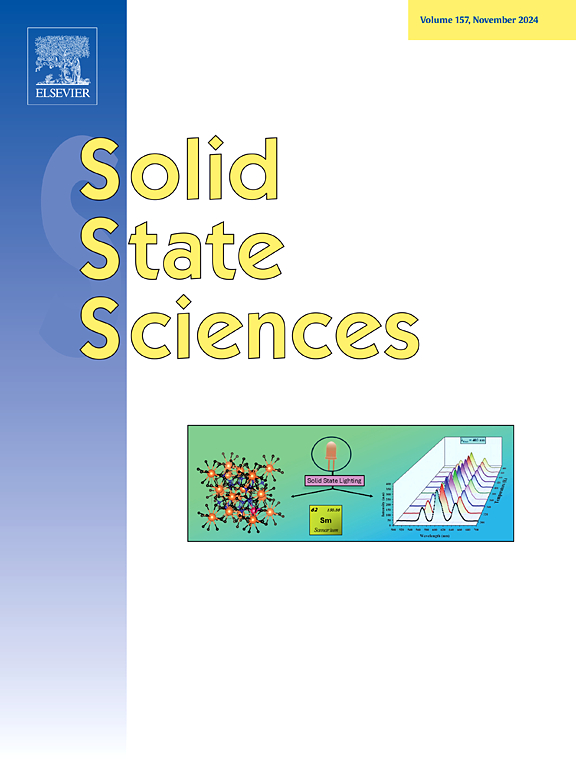生物炭负载Fe-MIL-88B衍生物纳米复合材料双途径催化降解四环素
IF 3.3
3区 化学
Q2 CHEMISTRY, INORGANIC & NUCLEAR
引用次数: 0
摘要
由于四环素(四环素)结构稳定,生物降解性低,因此开发一种高性价比、高效的四环素降解催化剂具有重要意义。本研究成功合成了一系列创新的核壳复合材料Fe/Fe3C@BC-0和Fe/Fe3C@BC-x (x = 0.3, 0.5, 1),其中Fe/Fe3C@BC-x是通过将Fe- mil - 88b原位加载到花生壳生物炭(BC)表面的高温煅烧前体合成的。研究了Fe/Fe3C@BC-0和Fe/Fe3C@BC-x投加量、PDS浓度、初始pH、初始TC浓度和共存阴离子对TC去除率的影响。与PDS + TC体系中单独氧化(5.8%)、BC(32.6%)和Fe/Fe3C@BC-0(72.6%)相比,Fe/Fe3[email protected]表现出优异的降解性能,在30 min内降解效率达到99.55%,降解速率常数(K值)为0.18 min−1,是Fe/Fe3C@C-0+PDS体系(0.043 min−1)的4倍。Fe/Fe3C@BC-x (x = 0.3, 0.5, 1)的优异效率可归因于双重降解途径的存在,即自由基(O2•-,•OH和SO4•-)和非自由基(1O2)降解。该研究为基于mof衍生物纳米复合材料和生物炭材料设计新型催化剂开辟了新的可能性。本文章由计算机程序翻译,如有差异,请以英文原文为准。

Dual pathways catalytic degradation of tetracycline realized by biochar supported Fe-MIL-88B derivative nanocomposite
Due to tetracycline's (TC) stable structure and low biodegradation, developing a highly cost-effective and efficient catalyst for the elimination of TC holds significant importance. In this study, series of innovative core-shell Fe/Fe3C@BC-0 and Fe/Fe3C@BC-x (x = 0.3, 0.5, 1) nanocomposites were successfully synthesized, where Fe/Fe3C@BC-x were synthesized by high-temperature calcination precursor of loading Fe-MIL-88B onto the surface of biochar (BC) from peanut hulls in situ. The effects of Fe/Fe3C@BC-0 and Fe/Fe3C@BC-x dosage, PDS concentration, initial pH, initial TC concentration, and coexisting anions on TC removal were studied. In comparison with the oxidation (5.8 %) by PDS alone, BC (32.6 %) and Fe/Fe3C@BC-0 (72.6 %) in the PDS + TC system, respectively, Fe/Fe3[email protected] exhibited exceptional degradation performance, 99.55 % degradation efficiency within just 30 min, and degradation rate constant (K value) of 0.18 min−1, which is quadruple higher than that in Fe/Fe3C@C-0+PDS (0.043 min−1). The outstanding efficiency of Fe/Fe3C@BC-x (x = 0.3, 0.5, 1) can be attributed to the presence of dual degradation pathways, namely, radical (O2•-, •OH, and SO4•-) and nonradical (1O2) degradation. This research opens up new possibilities for designing novel catalysts based on MOFs derivative nanocomposite and biochar materials.
求助全文
通过发布文献求助,成功后即可免费获取论文全文。
去求助
来源期刊

Solid State Sciences
化学-无机化学与核化学
CiteScore
6.60
自引率
2.90%
发文量
214
审稿时长
27 days
期刊介绍:
Solid State Sciences is the journal for researchers from the broad solid state chemistry and physics community. It publishes key articles on all aspects of solid state synthesis, structure-property relationships, theory and functionalities, in relation with experiments.
Key topics for stand-alone papers and special issues:
-Novel ways of synthesis, inorganic functional materials, including porous and glassy materials, hybrid organic-inorganic compounds and nanomaterials
-Physical properties, emphasizing but not limited to the electrical, magnetical and optical features
-Materials related to information technology and energy and environmental sciences.
The journal publishes feature articles from experts in the field upon invitation.
Solid State Sciences - your gateway to energy-related materials.
 求助内容:
求助内容: 应助结果提醒方式:
应助结果提醒方式:


